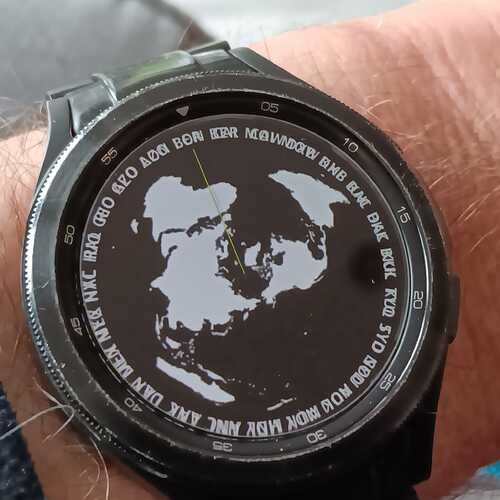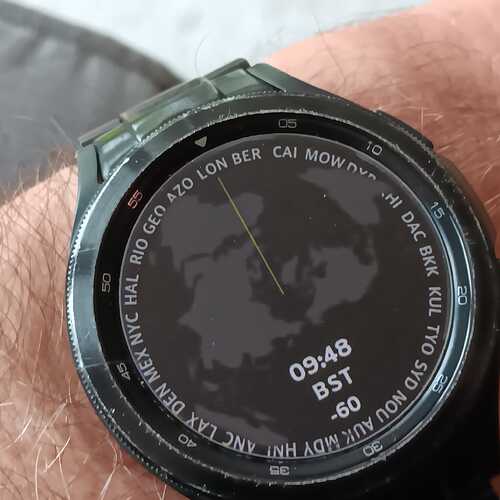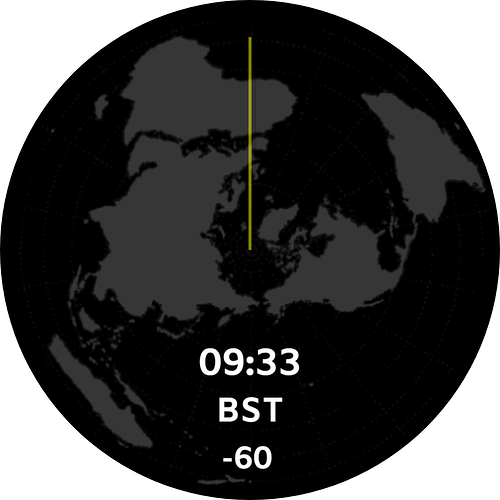Just a draft watch to test some time functions. I have tested them ( in my time zone ) and they seem to work ok. If you get the chance I would love it if you could check to see if the output on the watch is correct for your time zone.
Formulae:
UTC: #DUHZ#:#DUmZ#
UTC day number: ((floor((#DNOW#-946684800000)/86400000)%365)-floor(floor(((#DNOW#-946684800000)/86400000)/365)/4))
Equation of Time, EQT: (floor((-7.659sin((6.24004077+0.01720197((#DNOW#-946728000000)/86400000)%(2pi)))+9.863sin(2*(6.24004077+0.01720197*((#DNOW#-946728000000)/86400000)%(2*pi))+3.5932))*100)/100) in minutes
{ For those who don’t know, the EQT is the correction to account for the small annual shift in the position of the Sun about its mean position. It varies about +/- 16 minutes during the year; +ve means that the sun is ahead of the clock, -ve means that the sun is running late  . The EQT can be used to correct the time given by a sun dial. Equation of time - Wikipedia . This formula is an approximation only. There are better approximaitons but the ones I found require an inverse Tan function which Facer does not appear to have. This formula is typically good to around +/- 44 seconds with the the RMS a little less than half that.}
. The EQT can be used to correct the time given by a sun dial. Equation of time - Wikipedia . This formula is an approximation only. There are better approximaitons but the ones I found require an inverse Tan function which Facer does not appear to have. This formula is typically good to around +/- 44 seconds with the the RMS a little less than half that.}
Mean Sun: (floor((((#WSH#+(#WSm#/60))-(#WRH#+(#WRm#/60)))/2+(#WRH#+(#WRm#/60)))*1000)/1000) hrs
{ This is an approximation for the local solar midday - the local time at which the sun is directly overhead. For an observer in the middle of the timezone, solar midday should occur approximately half way between sunrise and sunset. As the observer moves away from the centre of the time zone the local midday also shifts - that is, solar midday is a function of longitude and the equation of time ( I think that EQT is already taken into account by the published Sunset and Sunset times, so no further correction for EQT should be needed to determine local solar midday). Note that daylight savings delays solar midday by an hour. }
Daylight savings: ((((((#WSH#+(#WSm#/60))-(#WRH#+(#WRm#/60)))/2+(#WRH#+(#WRm#/60))-((-7.659sin((6.24004077+0.01720197((#DNOW#-946728000000)/86400000)%(2pi)))+9.863sin(2*(6.24004077+0.01720197*((#DNOW#-946728000000)/86400000)%(2*pi))+3.5932))/60)))-12)>0.5)
{ This function uses the offset of local solar midday to determine if daylight savings has been addeded to the sunrise and sunset times. That is, it returns true if daylight savings is currently applicable at the observers site. I am not sure how accurate this function is as one moves away from the centre of the timezone. Nor am I certain what it might do with 1/2 time zones. I would love to know if you find that it does or does not work! }
Local solar time: (floor((((#DH#+(#Dm#/60)+(#Ds#/3600))-(((#WSH#+(#WSm#/60))-(#WRH#+(#WRm#/60)))/2+(#WRH#+(#WRm#/60)))+12)%24)*1000)/1000) hrs
{ This is an attempt to come up with an approximation for the local solar time - the time a sundial would display. Again I am not sure if it works outside of the zone I have tested it. I would love to hear from anyone if it works or does not }.






